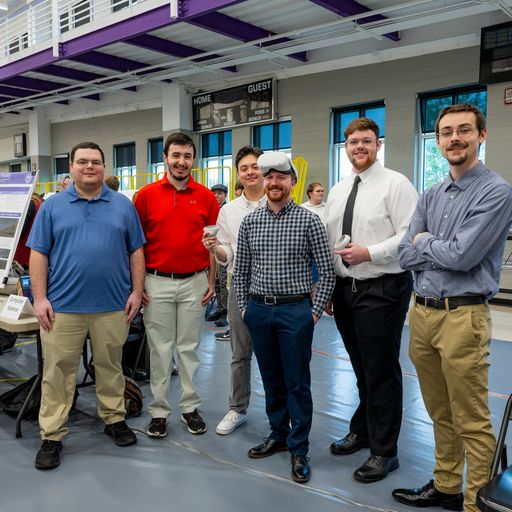Tech capstone project aims to bring World War I to life at Alvin C. York State Park

Left to right: Matthew Turner, Yago Romano, Ethan Hammond, Matthew Finder, Justin
Trapp and Noah Alasin.
A senior engineering capstone project at Tennessee Tech University has the power to
immerse visitors in the history of Alvin C. York State Park. They created a virtual
museum exhibit to bring the experiences of Alvin C. York during World War I to life.
Senior computer science majors Noah Alasin; Matthew Finder; Ethan Hammond; Yago Romano,
native of Spain; Justin Trapp, a Smithville native; and Matthew Turner, a McMinnville
native, came up with the idea after consulting with Park Ranger David Brady.
“Park Ranger David Brady met with us weekly to keep tabs on our progress with the
project and he laid out the three-scene structure that we would use for the story
progression of the exhibit,” Trapp said. “He was also responsible for providing us
with an outline, 3D assets and historical information.”
The group was responsible for the full creation of the exhibit, as well as figuring
out for themselves how they would “go about fleshing out the outline” they were given
to bring everything together.
“Our group was fortunate enough to already have multiple Meta Quest 2 headsets in
our possession that we used for testing,” Trapp said.
The students' process involved combining the multiple scenes they were working on
in the Unity Game Engine into one and compiling it into the headset to make sure everything
worked properly. They would do this in three-week intervals as they added in new features,
or sooner if needed for certain additions.
The students conducted public user testing at the university’s engineering senior
design expo that revealed several unintended facets of the exhibits that internal
testing had not shown. This allowed them to adjust as needed.
“The plan is currently for Park Ranger David Brady to take our work as proof of concept
to Alvin C. York State Park in order to potentially advance the project further and
implement it at the park,” Trapp said.
“The idea of having a VR to help visitors experience a more historically accurate
and immersive visit could potentially be implemented at any park anywhere for a cheap
price,” Romano said.
There are currently no other plans for other locations for this project specifically
as it is tailored to the history of Alvin C. York State Park. However, conversations
were had about how it could be the inspiration for the creation of other exhibits
that would relate more to other parks, and how they could be created through the modification
of this project, according to Trapp.
“Hopefully the park will provide further funding towards the project so that the features
we have developed can be enhanced by higher 3D model quality, and so that the project
can be implemented into the park itself," Trapp added.
Brady also has interest in taking the students’ work and handing it off to another
group of computer science students in the years to come to allow them to grow the
exhibit further, according to Trapp.
Turner said that he felt that this was “a great learning experience,” having never
used Unity or virtual reality prior to this project.
“In addition, I feel as though we have created a great foothold for the next team
using our project,” Turner said.
This project could easily be improved, according to Romano, as the team is made up
of computer science majors and not graphic designers or art majors, whose skillsets
could be put to use to improve the realism and immersion for visitors.
The Alvin C. York Institute was the sponsor for this project, specifically through
Brady, with the advisors being Brady, computer science professor William Eberle, and
class instructor Jamie Terral.
“Our group had a ton of fun working on this project and we consider ourselves lucky
to have been the group assigned to work on it. We all agree that we have gained invaluable
experience through this project and that we all further developed skills in areas
that we would not have had an opportunity to explore at the university otherwise,”
Trapp said. “We're happy that we were able to be the first ones in on designing something
that may inspire others to finalize virtual reality exhibits for Tennessee State Parks
moving forward.”

